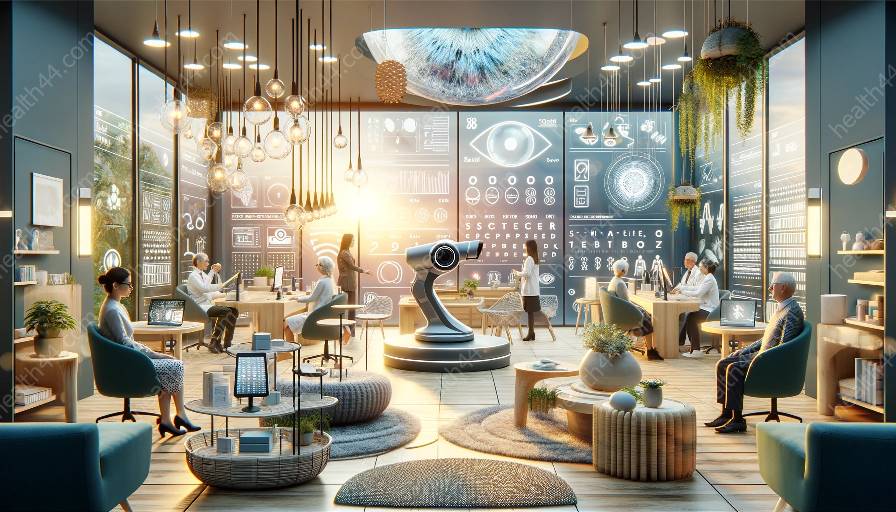Assistive technology plays a crucial role in promoting independent living and self-care, particularly for individuals undergoing vision rehabilitation. By empowering individuals with innovative tools and solutions, assistive technology enhances their ability to carry out daily activities and fosters greater independence. This topic cluster delves into the various aspects of how assistive technology contributes to promoting independent living and self-care, with a specific focus on its compatibility with vision rehabilitation.
Understanding the Significance of Assistive Technology in Promoting Independent Living and Self-Care
Before delving into the specifics of assistive technology’s role in promoting independent living and self-care, it’s essential to understand its overarching significance. Assistive technology encompasses a wide range of devices, tools, and software designed to support individuals with disabilities in leading fulfilling and independent lives. These technologies are tailored to address diverse needs, including mobility, communication, vision, and day-to-day activities.
When it comes to vision rehabilitation, assistive technology plays a pivotal role in empowering individuals who may experience vision impairment. By offering solutions that cater to visual challenges, such as screen readers, magnification tools, and wearable devices, assistive technology enables individuals to engage in daily activities with greater ease and autonomy.
The Intersection of Assistive Technology and Vision Rehabilitation
One of the key intersections within the realm of assistive technology lies in its compatibility with vision rehabilitation. Vision rehabilitation encompasses a range of services and strategies aimed at optimizing visual function and enhancing the independence of individuals with vision impairment. When paired with assistive technology, vision rehabilitation can leverage innovative tools to maximize its impact and empower individuals to embrace independent living with confidence.
Enhancing Everyday Activities with Assistive Technology
Assistive technology is instrumental in enhancing various aspects of daily living for individuals undergoing vision rehabilitation. Whether it’s reading, navigating unfamiliar environments, or communicating effectively, assistive technology offers tailored solutions to address specific challenges. Screen readers, for instance, convert text into speech, enabling individuals with visual impairments to access written content with ease. Furthermore, magnification tools and wearable devices equipped with advanced features empower individuals to navigate their surroundings and engage in activities that were once hindered by vision impairment.
Empowerment through Accessibility
Accessibility is at the core of promoting independent living and self-care with assistive technology in the context of vision rehabilitation. As technology continues to evolve, the focus on creating inclusive and accessible solutions has become increasingly paramount. With features such as voice commands, tactile interfaces, and customizable settings, assistive technology ensures that individuals with vision impairment can seamlessly integrate these tools into their daily routines, fostering a sense of empowerment and autonomy.
Latest Innovations in Assistive Technology
The landscape of assistive technology is marked by continual innovation, with new solutions and devices constantly emerging to address the evolving needs of individuals with disabilities, including those undergoing vision rehabilitation. Cutting-edge advancements encompass a wide spectrum of tools, from wearable devices that provide real-time navigation assistance to smart home systems equipped with accessibility features that cater to diverse needs.
Integration of Artificial Intelligence (AI)
Artificial intelligence has significantly contributed to the evolution of assistive technology, particularly in the realm of vision rehabilitation. AI-powered solutions, such as object recognition applications and intelligent navigation systems, have revolutionized the way individuals with vision impairment interact with their surroundings. By harnessing the capabilities of AI, assistive technology offers intuitive and adaptive solutions that seamlessly integrate into individuals’ lifestyles, thereby fostering a greater sense of independence and self-care.
Empowering Individuals through Education and Awareness
Amidst the advancements in assistive technology, education and awareness play a vital role in promoting its effective utilization among individuals undergoing vision rehabilitation. By providing comprehensive training and resources, individuals can harness the full potential of assistive technology to enhance their independence and self-care. Moreover, fostering awareness about the latest developments in assistive technology creates a supportive ecosystem wherein individuals feel empowered to explore and adopt innovative solutions tailored to their needs.
Collaborative Partnerships and Advocacy
Collaborative efforts among organizations, healthcare practitioners, and advocates serve as catalysts in driving the integration of assistive technology into vision rehabilitation programs. Through advocacy and partnerships, the accessibility and affordability of assistive technology can be enhanced, ensuring that individuals have access to the tools they need to promote their independent living and self-care effectively.
Conclusion
In conclusion, the symbiotic relationship between assistive technology and vision rehabilitation underscores the transformative impact of innovative tools and solutions in promoting independent living and self-care. By leveraging the latest advancements in assistive technology, individuals with vision impairment can navigate daily activities, engage in social interactions, and pursue their aspirations with newfound confidence and independence. As the landscape of assistive technology continues to evolve, it is imperative to prioritize accessibility, education, and collaborative efforts in order to maximize its potential in empowering individuals to embrace independent living and self-care.





















